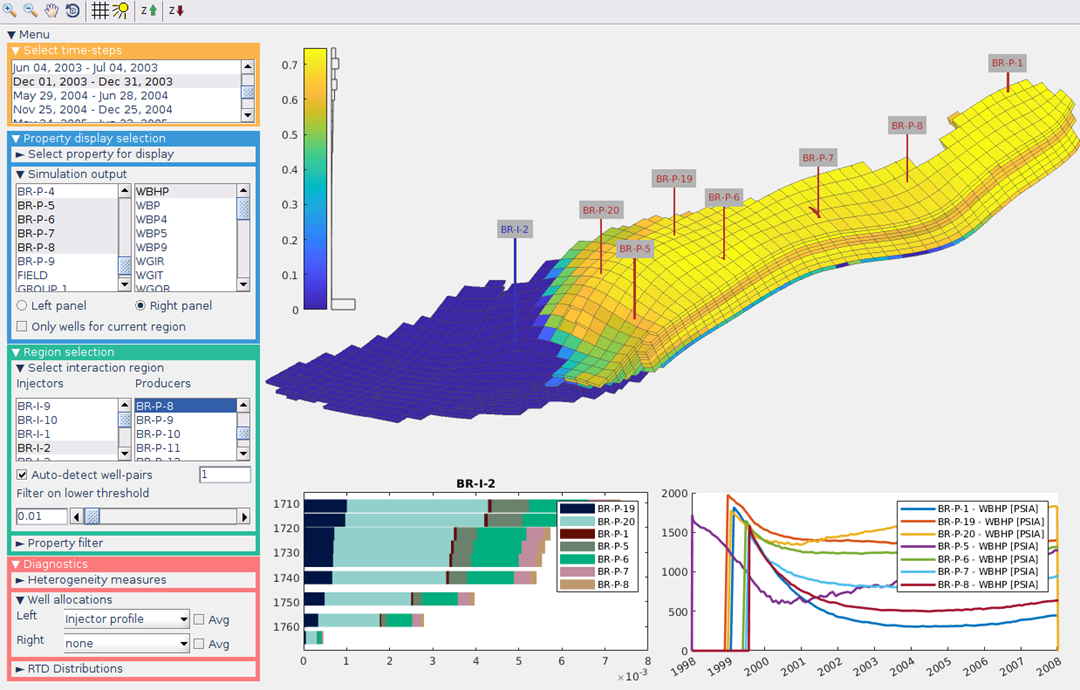Flow diagnostics: understanding the reservoir
High computational costs for reservoir simulation limits the engineers' ability to build cause-and-effect knowledge and systematically exploring alternative model scenarios. We have developed efficient prescreening and post-processing tools to complement advanced multiphase simulations in assessing the effect of heterogeneity and uncertainty in reservoir description, explore field-scale performance of alternative recovery strategies, and generally provide better decision support to optimize development and production plans. These tools can also be used to rank ensemble models, identify outliers, and select a smaller, representative subset that can be brought forward for more extensive (simulation) studies.
Effective data-driven modelling
A key question within digitalization and subsurface analytics is how to best utilize the abundance of information to make better decisions to improve oil recovery. Data-driven methods based on various forms of machine learning usually lack generality. We have studied physics-informed methods that use a traditional reservoir simulator as a data-driven model or as a proxy of itself, by calibrating the model to measured or simulated data, respectively. Unlike typical neural-network type models, the resulting models respect basic flow physics better maintain predictive power away from the data points used to train the model.
Optimized placement/operation of wells under uncertainty
We have developed and demonstrated efficient adjoint-based methods for well-placement optimization that use flow diagnostics proxies to avoid costly reservoir simulations of ensemble models, thereby significantly reducing the turnaround time of the optimization workflow.
Accelerating innovation: making methods accessible as open-source software
The new methods and workflows developed in the project are made available as library routines, graphical user interfaces (GUIs), and tutorial examples in diagnostics module of our open-source software, MRST.
- a GUI for postprocessing and enhanced visualization of reservoir-simulation results from ECLIPSE and MRST (see image the top of the page)
- a similar GUI for preprocessing geomodels so that dynamic responses can be estimated without running full simulations
- a GUI for ranking ensemble models, picking outliers, and selecting subsets of the available realizations/scenarios for further analysis
- a GUI for flow-diagnostics optimization of well trajectories
New methods for physics-informed, data-driven models and reduced-order models is released in the new network-models module of MRST.
Last, but not least, the project has given a number of software byproducts that have been released publicly as part of MRST:
- A new optimization module with methods for solving optimal control problems using a combination of adjoint equations and automatic differentiation. The module contains a quasi-Newton optimization routine using BFGS-updated Hessians, but can easily be set up to use any (non-MRST) optimization code. This module is used in well-placement optimization and for training data-driven models.
- A new ensemble module that offers functionality for ensemble simulation and optimization. The module also contains an implementation of multilevel Monte-Carlo framework for uncertainty quantification.
- A new example-suite module that offers a unified interface to a variety of benchmark and test cases, including functionality to systematically compare simulation setups and results and set up regression tests.
Validation and testing in representative environment
The methods developed in the project have been validated on many open data sets that represent varying degree of realism, including Brugge, Egg, Norne, Olympus, SAIGUP, SPE10. These validation studies are documented in the publications and the tutorial examples produced by the projects. We have also conducted successful validation and demonstration studies on real-field cases from the industry partners (Equinor, TotalEnergies, and Wintershall DEA), but these results are not published openly.






